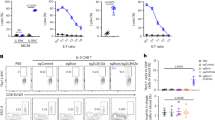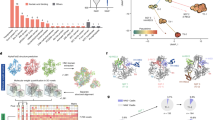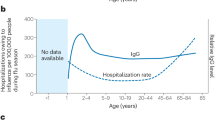Abstract
Hairy cell leukemia (HCL) is a chronic mature B-cell leukemia characterized by malignant B cells that have typical hairy protrusions. To characterize possible HCL-associated tumor antigens, we generated an HCL-specific and HLA class II (DPw4)-restricted proliferative CD4+ T-cell clone. To identify the target antigen of these T cells, we constructed a synthetic peptide library dedicated to bind HLA DPw4, and identified a mimicry epitope recognized by the T-cell clone. With this epitope, the recognition motif of the T-cell clone was deduced and a peptide of human synaptojanin 2 (Syn 2) was identified that stimulated the HCL-reactive T-cell clone. Both Northern and Western blot analyses showed that Syn 2 expression was increased in HCL samples compared to other B cells. Besides, the Syn 2-expressing cell line AML193, with the introduced restrictive HLA-DPw4 molecules, was recognized by the HCL-specific T-cell clone. These results indicate that Syn 2 is a target of autoreactive HCL-specific T cells. Since Syn 2 is a phosphatidylinositol 4,5-biphosphatase involved in cell growth and rearrangement of actin filaments, the increased Syn 2 expression may correlate with the disease etiology or the characteristic morphologic alterations caused by the disease.
This is a preview of subscription content, access via your institution
Access options
Subscribe to this journal
Receive 12 print issues and online access
$259.00 per year
only $21.58 per issue
Buy this article
- Purchase on Springer Link
- Instant access to full article PDF
Prices may be subject to local taxes which are calculated during checkout




Similar content being viewed by others
References
Cawley JC, Burns GF, Hayhoe GJ . Hairy-cell leukaemia. Recent Results Cancer Res 1980; 72: 1–123.
Zucker-Franklin D, Liebes LF, Silber R . Differences in the behavior of the membrane and membrane-associated filamentous structures in normal and chronic lymphocytic leukemia (CLL) lymphocytes. J Immunol 1979; 122: 97–107.
Kluin-Nelemans JC, Kester MGD, Melenhorst JJ, Landegent JE, van de Corput L, Willemze R et al. Persistent clonal excess and skewed T-cell repertoire in T cells from patients with hairy cell leukemia. Blood 1996; 87: 3795–3802.
Stark RS, Liebes LF, Shelanski ML, Silber R . Anomalous function of vimentin in chronic lymphocytic leukemia lymphocytes. Blood 1984; 63: 415–420.
Caligaris-Cappio F, Bergui L, Tesio L, Corbascio G, Tousco F, Marchisio PC . Cytoskeleton organization is aberrantly rearranged in the cells of B chronic lymphocytic leukemia and hairy cell leukemia. Blood 1986; 67: 233–239.
Berger R, Bernheim A, Valensi F, Flandrin G . 14q− in two hairy cell leukemia patients. Cancer Genet Cytogenet 1985; 16: 91–93.
Lewis JP, Tanke HJ, Raap AK, Kibbelaar RE, Kluin PM, Kluin-Nelemans HC . Hairy cell leukemia: an interphase cytogenetic study. Leukemia 1993; 7: 1334–1338.
Haglund U, Juliusson G, Stellan B, Gahrton G . Hairy cell leukemia is characterized by clonal chromosome abnormalities clustered to specific regions. Blood 1994; 83: 2637–2645.
Kluin-Nelemans HC, Beverstock GC, Mollevanger P, Wessels HW, Hoogendoorn E, Willemze R et al. Proliferation and cytogenetic analysis of hairy cell leukemia upon stimulation via the CD40 antigen. Blood 1994; 84: 3134–3141.
de Santi MM, Leoncini L, Del Vecchio MT . Tubuloreticular inclusions and viral particles in a case of hairy cell leukemia. Haematologica 1989; 74: 413–414.
Mantovani G, Santa CG, Serra MC . Tubuloreticular inclusions and viral particles in hairy cell leukemia. Haematologica 1990; 75: 403.
Kluin-Nelemans HC, Kester MGD, van de Corput L, Boor PPC, Landegent JE, van Dongen JJM et al. Correction of abnormal T-cell receptor repertoire during interferon-alpha therapy in patients with hairy cell leukemia. Blood 1998; 91: 4224–4231.
van der Horst FA, van der Marel A, den Ottolander GJ, Kluin-Nelemans HC . Decrease of memory T helper cells (CD4+ CD45R0+) in hairy cell leukemia. Leukemia 1993; 7: 46–50.
Van de Corput L, Kluin-Nelemans HC, Kester MGD, Willemze R, Falkenburg JHF . Hairy cell leukemia-specific recognition by multiple autologous HLA-DQ or DP-restricted T-cell clones. Blood 1999; 93: 251–259.
Hiemstra HS, Benckhuijsen WE, Amons R, Rapp W, Drijfhout JW . A new hybrid resin for stepwise screening of peptide libraries combined with single bead Edman sequencing. J Pept Sci 1998; 4: 282–288.
Falk K, Rotzschke O, Stevanovic S, Jung G, Rammensee HG . Pool sequencing of natural HLA-DR, DQ, and DP ligands reveals detailed peptide motifs, constraints of processing, and general rules. Immunogenetics 1994; 39: 230–242.
Lam KS, Salmon SE, Hersh EM, Hruby VJ, Kazmierski WM et al. A new type of synthetic peptide library for identifying ligand-binding activity. Nature 1991; 354: 82–84.
Lebl M, Krchnak V . Synthetic peptide libraries. Methods Enzymol 1997; 289: 336–392.
Hiemstra HS, Duinkerken G, Benckhuijsen WE, Amons R, de Vries RRP, Roep BO et al. The identification of CD4+ T cell epitopes with dedicated synthetic peptide libraries. Proc Natl Acad Sci USA 1997; 94: 10313–10318.
Falkenburg JHF, Harrington MA, Walsh WK, Daub R, Broxmeyer HE . Gene-expression and release of macrophage-colony stimulating factor in quiescent and proliferating fibroblasts. Effects of serum, fibroblast growth-promoting factors, and IL-1. J Immunol 1990; 144: 4657–4662.
Malecz N, McCabe PC, Spaargaren C, Qiu R, Chuang Y, Symons M . Synaptojanin 2, a novel Rac1 effector that regulates clathrin-mediated endocytosis. Curr Biol 2000; 10: 1383–1386.
Heemskerk MH, de Paus RA, Lurvink EGA, Koning F, Mulder A, Willemze R et al. Dual HLA class I and class II restricted recognition of alloreactive T lymphocytes mediated by a single T cell receptor complex. Proc Natl Acad Sci USA 2001; 98: 6806–6811.
Hiemstra HS, van Veelen PA, Schloot NC, Geluk A, van Meijgaarden KE, Willemen SJM et al. Definition of natural T cell antigens with mimicry epitopes obtained from dedicated synthetic peptide libraries. J Immunol 1998; 161: 4078–4082.
Heemskerk MH, Blom B, Nolan G, Stegmann APA, Bakker AQ, Weijer K et al. Inhibition of T cell and promotion of natural killer cell development by the dominant negative helix loop helix factor Id3. J Exp Med 1997; 186: 1597–1602.
Chiari R, Hames G, Stroobant V, Texier C, Maillere B, Boon T et al. Identification of a tumor-specific shared antigen derived from an Eph receptor and presented to CD4T cells on HLA class II molecules. Cancer Res 2000; 60: 4855–4863.
Fujii S, Uemura Y, Iwai LK, Ando M, Senju S, Nishimura Y . Establishment of an expression cloning system for CD4+ T cell epitopes. Biochem Biophys Res Commun 2001; 284: 1140–1147.
Verreck FAW, Vermeulen C, Poel van A, Jorritsma P, Amons R, Coligan JE et al. The generation of SDS-stable HLA DR dimers is independent of efficient peptide binding. Int Immunol 1996; 8: 397–404.
van de Wal Y, Kooy YMC, Drijfhout JW, Amons R, Papadopoulos GK, Koning F . Unique peptide binding characteristics of the disease-associated DQ(alpha 1*0501, beta 1*0201) vs the non-disease-associated DQ(alpha 1*0201, beta 1*0202) molecule. Immunogenetics 1997; 46: 484–492.
van de Wal Y, Kooy YMC, Drijfhout JW, Amons R, Koning F . Peptide binding characteristics of the coeliac disease-associated DQ(alpha1*0501, beta1*0201) molecule. Immunogenetics 1996; 44: 246–253.
Gundlach BR, Wiesmuller KH, Junt T, Kienle S, Jung G, Walden P . Determination of T cell epitopes with random peptide libraries. J Immunol Methods 1996; 192: 149–155.
Hemmer B, Fleckenstein BT, Vergelli M, Jung G, McFarland H, Martin R et al. Identification of high potency microbial and self ligands for a human autoreactive class II-restricted T cell clone. J Exp Med 1997; 185: 1651–1659.
Hiemstra HS, van Veelen PA, Geluk A, Schloot NC, de Vries RRP, Ottenhoff THM et al. Limitations of homology searching for identification of T-cell antigens with library derived mimicry epitopes. Vaccine 1999; 18: 204–208.
Nemoto Y, Arribas M, Haffner C, DeCamilli P . Synaptojanin 2, a novel synaptojanin isoform with a distinct targeting domain and expression pattern. J Biol Chem 1997; 272: 30817–30821.
Sakisaka T, Itoh T, Miura K, Takenawa T . Phosphatidylinositol 4,5-bisphosphate phosphatase regulates the rearrangement of actin filaments. Mol Cell Biol 1997; 17: 3841–3849.
Takenawa T, Itoh T, Fukami K . Regulation of phosphatidylinositol 4,5-bisphosphate levels and its roles in cytoskeletal re-organization and malignant transformation. Chem Phys Lipids 1999; 98: 13–22.
Guo S, Stolz LE, Lemrow SM, York JD . SAC1-like domains for yeast SAC1, INP52, and INP53 and of human synaptojanin encode polyphosphoinositide phosphatases. J Biol Chem 1999; 274: 12990–12995.
McPherson PS, Garcia EP, Slepnev VI, David C, Zhang X, Grabs D et al. A presynaptic inositol-5-phosphatase. Nature 1996; 379: 353–357.
Vieira AV, Lamaze C, Schmid SL . Control of EGF receptor signaling by clathrin-mediated endocytosis. Science 1996; 274: 2086–2089.
So CW, So CK, Cheung N, Chew SL, Sham MH, Chan LC . The interaction between EEN and Abi-1, two MLL fusion partners, and synaptojanin and dynamin: implications for leukaemogenesis. Leukemia 2000; 14: 594–601.
Taki T, Shibuya N, Taniwaki M, Hanada R, Morishita K, Bessho F et al. ABI-1, a human homolog to mouse Abl-interactor 1, fuses the MLL gene in acute myeloid leukemia with t(10;11)(p11.2;q23). Blood 1998; 92: 1125–1130.
Ramjaun AR, McPherson PS . Tissue-specific alternative splicing generates two synaptojanin isoforms with differential membrane binding properties. J Biol Chem 1996; 271: 24856–24861.
Khvotchev M, Sudhof TC . Developmentally regulated alternative splicing in a novel synaptojanin. J Biol Chem 1998; 273: 2306–2311.
Acknowledgements
We thank Reinout Amons and Peter van Veelen (Leiden University Medical Center) for their help with protein sequencing and mass spectrometry. We also thank Roel de Paus (Leiden University Medical Center) for his technical advice for the viral transduction studies. This work was supported by a grant from the Dutch Cancer Society.
Author information
Authors and Affiliations
Rights and permissions
About this article
Cite this article
Spaenij-Dekking, E., Van Delft, J., Van der Meijden, E. et al. Synaptojanin 2 is recognized by HLA class II-restricted hairy cell leukemia-specific T cells. Leukemia 17, 2467–2473 (2003). https://doi.org/10.1038/sj.leu.2403174
Received:
Accepted:
Published:
Issue Date:
DOI: https://doi.org/10.1038/sj.leu.2403174
Keywords
This article is cited by
-
SYNJ2 is a novel and potential biomarker for the prediction and treatment of cancers: from lung squamous cell carcinoma to pan-cancer
BMC Medical Genomics (2022)
-
Update on the Biology and Treatment Options for Hairy Cell Leukemia
Current Treatment Options in Oncology (2014)
-
Characterization of T-cell repertoire in hairy cell leukemia patients before and after recombinant immunotoxin BL22 therapy
Cancer Immunology, Immunotherapy (2006)
-
Clonally expanded T cells in hairy cell leukemia patients are not leukemia specific
Leukemia (2004)



